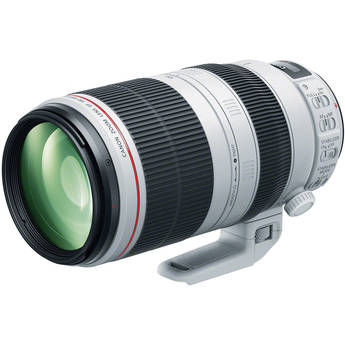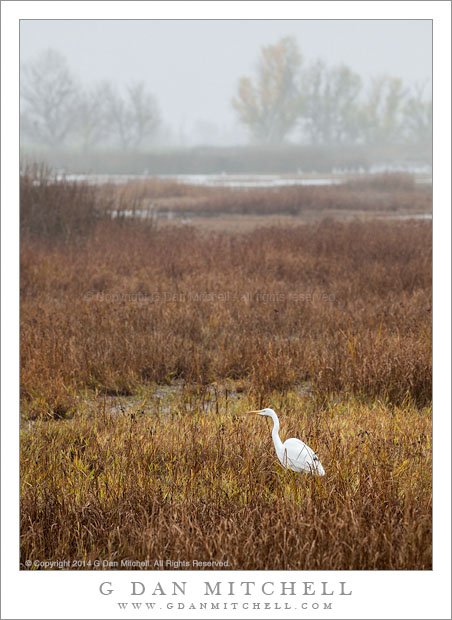(Note: Updated 12/24/14 to add thoughts about “who should buy” this lens.)
 Canon EF 100-400mm f/4.5-5.6L IS II
Canon EF 100-400mm f/4.5-5.6L IS II
Canon recently released the successor to their venerable 100-400mm telephoto zoom lens, the new EF 100-400mm f/4.5-5.6L IS II lens. I have relied on the older model for some time now… but my copy of the new lens arrived a few days ago. Now that I have used it for a day of wildlife and landscape photography I would like to share some first impressions

Four Sandhill Cranes. San Joaquin Valley, California. December 22, 2014.
© Copyright 2014 G Dan Mitchell — all rights reserved.
First, a few technical details. The new lens covers essentially the same range as the older model — a focal length range of 100mm to 400mm and a variable aperture range of f/4.5 (at 100mm) to f/5.6 (at 400mm). Both lenses use a zoom mechanism that extends at longer focal lengths. However, there are some technical differences:
- The old lens used a “push/pull” zoom mechanism, and the photographer changed focal length by sliding the front portion of the lens in and out. (Some liked this design and some did not — I liked it.) The new lens uses a more familiar rotational zoom ring to change focal length.
- On the old lens the manual focus ring was at the front of the lens, positioned further from the camera body. The new lens places the focus ring closest to the camera body and the zoom ring is further out.
- Both lenses have an image-stabilization (IS) system to reduce the effect of camera shake at low shutter speeds — a useful feature on telephoto lenses that will be used without a tripod. However, the new lens increases the number of stops of image stabilization from two to four, allowing handheld use at longer shutter speeds.
- The image stabilization system on the new lens adds a new mode 3. This mode, like mode 2 on the old lens, compensates for vibration in one dimension only, making it useful for panning. The difference is that it does not operate until the camera shutter is depressed (or half-depressed), which reduces the amount of “wandering” in the viewfinder image that otherwise can occur as the shot is composed.
- The position of the lens controls has been moved a bit, placing them all close to the camera body.
- The new lens comes with an updated lens hood. It uses the newer Canon “push button” design the locks more firmly. It also introduces a “window” on the side with a sliding cover which provides access to attached filters— useful for adjusting polarizing filters while the hood is attached.
- The new lens offers a redesigned tripod foot. On the old lens, the entire ring attached to the foot was removable — on the new lens the foot itself detaches from the ring around the lens. (At least some tripod foot plates for the old lens will work on the new one — for example, my RRS L84 works on both.)
- The new lens will autofocus with the 1.4x teleconverter (TC) attached on some Canon cameras. (In general, it will work with the newer DSLRs — it reportedly works with the 5D3, but not with my older 5D2.) If you have a newer Canon DSLR you can get a 160mm-560mm range at f/8 maximum aperture with the new lens. (The old lens will not autofocus at maximum apertures smaller then f/5.6, so it is not fully compatible with the f.4x TC, at least not if you want AF.)

Egret on the Hunt. San Joaquin Valley, California. December 22, 2014.
© Copyright 2014 G Dan Mitchell — all rights reserved.
While I have not conducted substantial objective tests on the lens, I did use it for a full day of photographing migratory birds and tripod-based landscape subjects, in light ranging from a foggy predawn to moments of late-afternoon sunshine. Not only did this give me a chance to learn more about the operational aspects of the lens, but it also gave me over 600 raw images to inspect and take through my post-processing workflow. Based on this, here are a few observations:
- Image quality is excellent at all focal lengths and apertures. There seems to be a small amount of chromatic aberration (CA), but nothing unusual, and it is easily correctable in post. At least at the long focal lengths the lens does produce noticeable vignetting wide open, but it disappears once you stop down. Overall I’m very happy with the optical performance of the lens.
- The lens handles very well — though if you are used to the push/pull 100-400mm lens, as I am, you are going to have to retrain yourself. The relative positions of the zoom and focus rings are reversed by comparison to many other Canon zoom lenses. The manual focus ring is close to the camera body and the zoom ring further out, unlike the older lens which put the focus further from the body and unlike some other zooms that put the zoom ring closest… so expect to grab the wrong ring at first.
- The zoom mechanism is quite quick, and you don’t have to rotate it far to fully extend or retract the lens.
- The IS is significantly better than that of the old lens. I made a number of careful handheld photographs of landscape subjects at long focal lengths, and managed to get very sharp images even at somewhat long shutter speeds.
- The autofocus system (AF) seems generally quite good and better than the older version of the lens. With all AF points activated the lens acquired focus quickly and accurately, even in poor light. The AI servo setting worked very well with my camera. With this mode enabled the lens acquired focus as quickly as I could frame the new composition. For some bird photography I use only the center point — and I felt that the lens sometimes hunted with this setup in very low contrast, foggy and drizzly conditions, thought this might be a 5DII camera issue.
- For me, the jury is still out on the little “window” on the hood that is supposed to open to allow access to a polarizing filter. I kept finding that it had opened on its own — and I’ll have to figure out why. I doubt that it matters too much in most situations, especially since I position it at the bottom of the lens
- My L84 Really Right Stuff (RRS) tripod plate from my old 100-400 fits on the foot of new lens. I can’t say for certain, but I suspect that plates from other manufacturers that worked on the older 100-400 lens will also work on the new one. (Check with your manufacturer before making a purchase.) It will be interesting to see if manufacturers like RRS stick with the existing models or design new ones for the new lens.
Overall, this lens continues Canon’s recent pattern of updating older existing lens designs to improve them functionally and optically — and this update seems like a real success to me.
Who will want this lens?
And who might not? Here are some general thoughts on the subject:
- Upgraders from the older Canon 100-400mm lens — If you have an older copy of the previous 100-400 you might be interested in upgrading, but the upgrade will not necessarily be for everyone. The new lens is better in just about every way, but you always need to ask yourself how much that “better-ness” will actually affect your photography. I think you are a pretty good candidate for the upgrade if your current lens is older and especially if it is starting to show signs of aging (focus issues, tension ring issues), and/or if your photography is pushing the boundaries of what the old lens can do. If you have been pleased with the performance of your current 100-400mm lens, you may not want to rush into upgrading. (Having an older copy of the lens to sell reduces the sting of the $2199 price, but the presence of the new model also will reduce the going price for used copies of the original.) Obviously, I felt that the upgrade was worth it for me.
- New telephoto zoom buyers — If you do not have a long telephoto zoom with this focal length range and you need one, getting the new model is the obvious choice — unless you are constrained by the price, in which case the secondary good news is that you should now be able to find a good used copy of the old model at a lower price. For those considering the new lens, the v.II lens incorporates all of the most current features, and waiting isn’t likely to produce anything better.
- Augmenting/supplanting other Canon telephoto options — Any time the subject of this sort of lens comes up, I see a lot of discussions of the relative merits of telephoto zooms versus primes and of the option of adding a teleconverter ( or “TC”) to shorter zooms, such as the excellent 70-200mm Canon lenses, or to telephoto primes, such as the 200mm, 300mm, or 400mm models. Comparing all of these options quickly becomes quite complicated, and the right answer for one person will be the wrong answer for someone else. In ideal situations the primes can produce the best possible image quality — but the new lens has truly excellent image quality, and it is far more flexible. TCs can give your existing lens a longer range, often with very good image quality — but there is a certain inconvenience factor to consider, depending on your anticipated usage. To make a generalization with lots of potential footnotes and exceptions, I can say that most folks who need/want to cover this focal length range will be happiest with the zoom. (I won’t go into all of the reasons or the exceptions in this paragraph, but leave a comment below if you want to know more about my reasoning.)
Leave a comment below if you have any questions about my experience with the lens, and I’ll try to answer on this page.
If this review is useful to you as you make a decision about the EF 100-400mm f/4.5-5.6L IS II lens, purchasing the lens from site-sponsor B&H photo through the links on this page helps to support the website. Thanks!
 G Dan Mitchell is a California photographer and visual opportunist whose subjects include the Pacific coast, redwood forests, central California oak/grasslands, the Sierra Nevada, California deserts, urban landscapes, night photography, and more.
G Dan Mitchell is a California photographer and visual opportunist whose subjects include the Pacific coast, redwood forests, central California oak/grasslands, the Sierra Nevada, California deserts, urban landscapes, night photography, and more.
Blog | About | Flickr | Twitter | Facebook | Google+ | 500px.com | LinkedIn | Email
Text, photographs, and other media are © Copyright G Dan Mitchell (or others when indicated) and are not in the public domain and may not be used on websites, blogs, or in other media without advance permission from G Dan Mitchell.
Discover more from G Dan Mitchell Photography
Subscribe to get the latest posts sent to your email.
